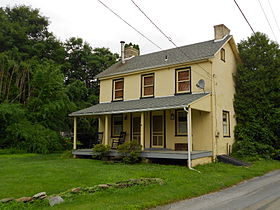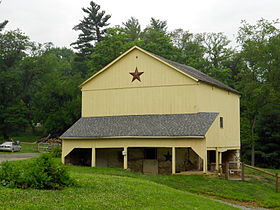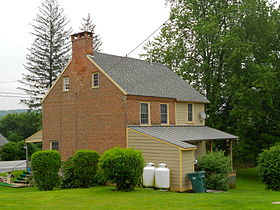
Sugartown is an unincorporated settlement that is located in central Willistown Township, Chester County, Pennsylvania, United States, at the intersection of Sugartown and Boot Roads. It is situated eighteen miles west of Philadelphia.

This is a list of the National Register of Historic Places listings in Columbia County, Pennsylvania.
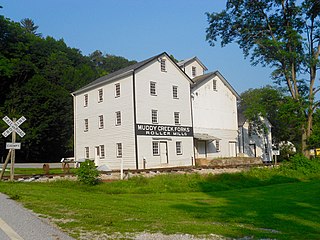
The Muddy Creek Forks Historic District is a national historic district that is located in the Village of Muddy Creek Forks in East Hopewell, Fawn, and Lower Chanceford Townships in York County, Pennsylvania.
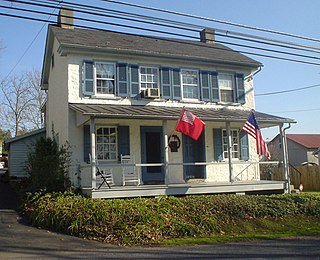
Chadds Ford Historic District is a national historic district located at Chadds Ford Township, Delaware County, Pennsylvania. The district includes 17 contributing buildings in Chadds Ford village. Notable buildings include the Chads Ford Inn (1807-1810), Merchant Mill (1864), a row of houses built between 1840 and 1850, the bridge across Brandywine Creek, and the Christian C. Sanderson Museum. Located in the district are the separately listed Chad House and N. C. Wyeth House and Studio.

Brownsville Commercial Historic District is a national historic district located adjacent to the Brownsville Northside Historic District at Brownsville, Fayette County, Pennsylvania. The district includes 55 contributing buildings and two contributing structures in the central business district of Brownsville. Most of the contributing buildings are three and four-story brick commercial buildings built between 1900 and 1930, with four buildings dated to the 19th century. The oldest building is the Flatiron Building. Other notable buildings include the International Order of Odd Fellows Building (1876), Monongahela National Bank (1902), Second National Bank (1916), Snowdon Building (1907), Union Station (1928), Crawford Building (1908), and Borough Building (1940). The contributing structures are the separately listed Dunlap's Creek Bridge and a stone railroad tunnel (1903).

The Hays Bridge Historic District is a national historic district which is located in Montgomery Township, Franklin County, Pennsylvania.

David Davis Farm, also known as the Christian Summers Farm and John Martin Farm, is a historic farm and national historic district located at Earl Township, Lancaster County, Pennsylvania. The district includes seven contributing buildings and one contributing site. They include the farmhouse, a stone bank barn, spring house, two frame tobacco barns, a small frame shed, and family burial ground. The farmhouse is an evolutionary dwelling originally built as a two-story, stone building about 1750, and extensively remodeled in 1787. Stone and frame additions were made about 1815, about 1870, and about 1890. Attached to the house is a small frame summer kitchen with beehive oven, that was once a separate structure.

The Kirks Mills Historic District is a national historic district that is located in Little Britain Township, Lancaster County, Pennsylvania, United States.

Chickies Historic District is a national historic district located at East Donegal Township, West Hempfield Township, and Marietta, Lancaster County, Pennsylvania, United States. The district includes 32 contributing buildings, 16 contributing sites, and four contributing structures in three areas. They are: 1) floodplain along the Susquehanna River containing archaeological remains of iron furnaces; 2) the "Ironmasters' Hill" area of Marietta with five residences associated with ironmasters ; and 3) the Donegal Creek area with farmland, iron pits, and limestone quarries owned by the ironmasters.

The Perkiomen Bridge Hotel, also known as Lane's Hotel, is a historic, American hotel complex that is located adjacent to the Perkiomen Bridge in Collegeville, Montgomery County, Pennsylvania.

Bergy Bridge Historic District is a national historic district located near Harleysville in Upper Salford Township, Montgomery County, Pennsylvania. It encompasses four contributing buildings and two contributing structures. They are the Bergy Stone Arch Bridge (1848), Kratz House and Barn, German garden, Bergy Inn, and Stable Building.

Danville West Market Street Historic District is a national historic district located in Danville, Montour County, Pennsylvania. It encompasses 42 contributing buildings in a residential area of Danville. The buildings date from about 1800 to 1925. The houses are mostly of brick and frame construction, with some log and stone dwellings, and in a variety of architectural styles including Italianate, Federal, Queen Anne and Second Empire.

Alexander K. McClure School is a historic elementary school located in the Hunting Park neighborhood of Philadelphia, Pennsylvania. It is part of the School District of Philadelphia. The building was designed by Henry deCourcy Richards and built in 1910–1911. It is a three-story, five-bay, brick building with a raised basement in the Colonial Revival-style. It features a three-story, rounded arched opening above the entrance, stone trim, and a rounded parapet. An addition was built in 1967. The school was named for journalist and politician Alexander Kelly McClure.
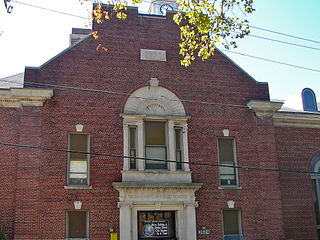
The Thomas Mifflin School is an historic, American school that is located in the East Falls neighborhood of Philadelphia, Pennsylvania. It is part of the School District of Philadelphia.

The Trexler Historic District, also known as Trexler Station, is a national historic district that is located in Albany Township, Berks County, Pennsylvania.

Center Bridge Historic District is a national historic district located in Solebury Township, Bucks County, Pennsylvania. The district includes 60 contributing buildings, 2 contributing sites, and 3 contributing structures in the village of Center Bridge. Notable buildings are the William Mitchell / Edward R. Redfield House and a unique row of two-family workers' dwellings. Also located in the district is the separately listed Isaiah Paxson Farm.

Dolington Village Historic District is a national historic district located at Dolington, Upper Makefield Township and Lower Makefield Township, Bucks County, Pennsylvania. The district includes 64 contributing buildings, 2 contributing sites, and 4 contributing structures in the crossroads village of Dolington. The largely rural residential district includes representative buildings of the vernacular Federal and Gothic styles. The buildings were mostly built between 1800 and 1875. Notable buildings include the John L. Cox House, Joseph Moon House, Balderson House, John Harris House (1803), William Thornton House, John B. Alcutt House, Dolington Schoolhouse (1860),. The district also includes the ruins of the Canby / Davis Blacksmith Shop.

The Butler Historic District is a national historic district which is located in Butler, Butler County, Pennsylvania.

The John Williams Farm, also known as the Davis B. Williams Farm and Stinson Markley Residence, is an historic farm complex and national historic district that are located in Charlestown Township, Chester County, Pennsylvania.
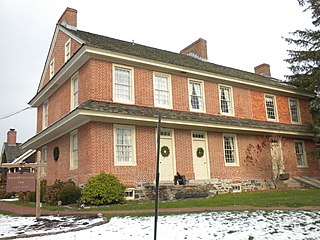
Dilworthtown Historic District is a national historic district located in Dilworthtown, Birmingham Township, Chester County, Pennsylvania. It encompasses eight contributing buildings in the crossroads community of Dilworthtown. They include the Dilworth House, stone house (1820), Dilworthtown Lyceum or meeting hall, Dilworthtown Store (1858), two tenant houses, and a two-story log cabin dated to 1686 or the early-18th century. The focal point of the district is the Dilworth House, also known as the Dilworthtown Inn, which has operated as an inn and tavern since the late 18th century. The town was at the center of the fighting during the Battle of Brandywine in September 1777.



